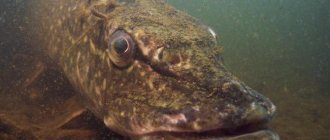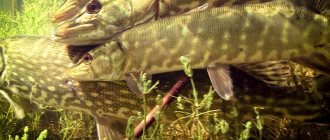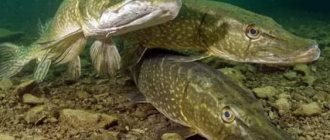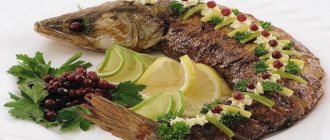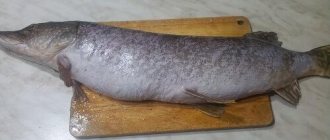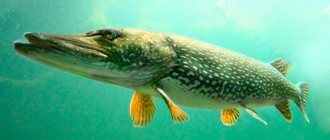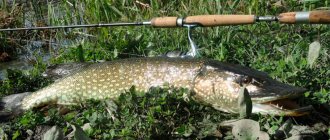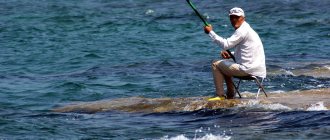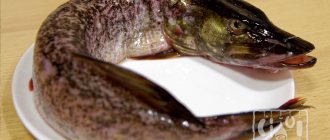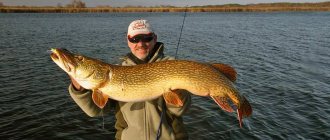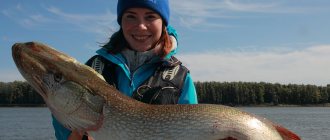Description of the species
Molva fish (scientific Latin name molva), belongs to the species of ray-finned fish, the order Cod-like fish. The photo shows how much its elongated body and snout resemble a river fish and is not at all like cod. Sea pike can reach two meters in length and 45 kilos, but usually it is 63 cm - 1.6 m and weighs 20-25 kg. Its scientific name is pronounced exactly like that - Molva, in no case malva. Everyone knows that mallow is a garden herbaceous plant with beautiful multi-colored flowers.
Yandex pictures
There are two fins on the back, one short with up to 16 rays, the second with up to 70 rays. The tail is rounded, similar to a short fan. The pelvic fins are located in front of the pectoral fins and are red with black and white edges, as are the hind, anal, and tail.
The scales of the two-meter-long mallow are smooth and fit tightly to the thick skin. The back and head are colored reddish-brown, which becomes lighter towards the sides and turns completely white on the belly.
INTERESTING: Like most fish of the Atlantic basin, they have a chin barbel that performs a sensory function. The maximum age of males is 10, females 14 years.
Facts about pike
In addition to its specific appearance, pike has many other differences.
Natural enemies
The pike itself is a predator and has few enemies. The exception is otters and eagles, which sometimes hunt it and are very successful. In the southern regions, pike can be attacked by catfish.
Small-sized representatives are also hunted by perch, rotan, and large pike perch. The pike is also destroyed by the person for whom it represents a real trophy.
How does a pike attack in water?
The pike attacks the victim quickly, making 1 or 2 bites with its jaws. Once in the mouth of a predator, small fish are practically doomed to death, since their teeth literally cut like a razor. Having swallowed the bait, the pike pulls it into the shelter, so you cannot immediately pull out the predator.
After some time, the pike will try to turn the bait over and swallow it (about 15 seconds after the attack).
Why is pike called a freshwater shark?
Due to its aggressiveness and gluttony, pike is sometimes called a freshwater shark. The predators have a lot in common: both love to swim alone and feed on small fish, shrimp and crustaceans. They do not attack humans, but behave aggressively.
The lifespan of sharks reaches 30 years, and pikes, in most cases, live much shorter lives (up to 7 years) due to pollution of rivers and reservoirs. There is also a difference in size - sharks are much larger than giant pike.
What happens if you throw a pike towards piranhas?
Teenagers sometimes undertake such experiments for the sake of an interesting video on YouTube. The problem is that piranhas live in a different environment than freshwater pike and, once in the wrong environment, the toothy predator immediately dies.
Is a pike bite dangerous, have there been attacks on humans?
A pike can bite a fisherman. Such cases have happened more than once. A fish bite can be dangerous because the predator's teeth are very sharp and mobile. It is advisable to always have a patch, brilliant green or iodine with you to treat the bite site.
You should only climb into the mouth of a fish using a gaper so that it does not have time to close its mouth and injure your hand.
Life and reproduction
Molva fish is an inhabitant of the bottom soil on a rocky, stony bottom at a depth of 15 to 600 meters, usually 100-400 m. Young sea pike up to 1-2 years old are coastal (depth 15-20 m) and pelagic. Fish at the age of 3 years migrate to greater depths. The first maturity occurs at 5 years for males (80) and at 5-6 years for females (90-100 cm). Molva do not live in large flocks, they love secluded places after shipwrecks, and only from March to June they gather in large numbers for the spawning grounds.
Spawning occurs with the onset of spring and lasts until mid-summer, eggs float and develop in the water column. Fecundity can reach from 20 to 60 million eggs per moth. The main spawning grounds are located at a depth of 200 m from the Bay of Biscay to the Gulf of Norway, at a distance of 100 to 300 m from the south of Iceland and from 50 to 300 m in the Mediterranean Sea.
FACT: Growth is fast (8-10 cm per year). H 1 – 20 cm; 2 – 31-35 cm; 3 – 31-35 cm; 4 – 73-83 cm. Females grow faster than males.
Pike fishing methods
Pike is caught throughout the year. Large individuals more often bite the bait in the morning, and in windy weather - in the middle of the day. On cloudy days, fishing is more successful than on sunny days.
When fishing for a pike on a spinning rod, it can shake its teeth and jump off, so you need to be very careful. The secret to a successful hunt is to search for hidden “pike” places (deep, snag areas, whirlpools, rolling holes).
Amateur and poaching gear
They catch the predator with a spinning rod, a line, winter live bait, float and bottom fishing rods, mugs and other gear. For fishing on a large scale, fixed nets are used. They often catch it from the shore with live bait, in the pools with a sinking wobbler, and from a boat with tackle with a large bleak.
Used for fishing:
- supply;
- girder;
- circle;
- live bait fishing rod;
- winter harness and other gear.
Poachers use various methods, including traps that are not prohibited by law.
Hunting for live bait is prohibited on the territory of wintering pits while the corresponding ban is in effect.
Otherwise, you can fish in all permitted fishing areas all year round. When fishing for live bait, you can use up to five gear (rods, circles, girders or donks), with a total number of hooks equal to five.
Unconventional fishing methods
Unconventional methods are also used to catch predators. For example, fishing with unloaded rubber with imitation fish in places where there is a high risk of catching classic baits: spinners with a tee or wobblers.
Silicone baits of various sizes (mainly for small fish or shrimp) are superior to all other types of devices for catching predators.
The bait is thrown into the water and the fishing line is reeled in. During this process, the bait begins to vibrate, attracting a predator. For fishing, they also use a trap (single or double), jamming on the first ice, and sometimes a crossbow or bow.
Taste qualities, KBJU, vitamins
On the Internet you can find many photos of dishes and recipes made from molva. It is served boiled and baked, fried and stewed, as well as salted and smoked; fish meal is produced. The main thing is to choose a high-quality frozen, ready-made or fresh product. In taste, vitamin and mineral content, the fish resembles pike and balanus. The Spaniards love linga caviar; they consider it a delicacy.
Yandex pictures
Calorie content – 87 kcal
Proteins – 18.99 g
Fats – 0.64 g
Carbohydrates – 0
Vitamins and minerals
Molva contains the most B5 (0.32 mg), which helps the body produce adrenal hormones and blood antibodies to strengthen the immune system.
This is followed by B6 (0.304 mg), which is necessary for brain function, improved memory, and helps prevent cardiovascular diseases.
B1 (11 mg), slows down the aging process, protects against alcohol and smoking.
Vitamin A (30 mcg), even such a small amount with constant use, will rejuvenate skin cells, strengthen hair and teeth.
Potassium (379 mg) – important for muscle strength and nervous system functioning.
Phosphorus (198 mg) – needed for the health of internal organs and bone tissue.
Selenium (36.5 mcg) – protects body cells from damage, ensures proper metabolism and normal functioning of the thyroid gland.
The benefits and harms of pike for humans
Pike has a lot of useful properties and has a beneficial effect on the human body. Its only drawback: fish caught in dirty waters will most likely be infected with harmful bacteria or even parasites, so it is better to avoid hunting in such places.
What are the benefits of meat and liver for humans?
Pike meat contains 1-3% fat and is a dietary product (100 grams of pike contains only 84 kcal). Meat contains vitamins PP, E, C, B9, B6, B2, B1, A, and many valuable minerals. Pike is often recommended for those who have problems with the heart, blood vessels, and a predisposition to diabetes.
Fish oil regulates blood cholesterol levels and has a positive effect on the gastrointestinal tract. Pike caviar normalizes blood pressure and increases hemoglobin in the blood. The liver of a predator is considered a real delicacy, as it contains a lot of healthy fat and microelements.
Pike meat is often fried in batter and used for dietary salads and other dishes. The liver of a predator contains vitamins (B1, B2 and PP), which improve the metabolism of fats and proteins in the body. Pike contains a lot of phosphorus, iron and calcium. They are necessary for those who are engaged in mental activity or study.
However, fish also has disadvantages. It can accumulate harmful bacteria and substances if it is in bodies of water where sewage flows, so it is best to eat fish caught in environmentally friendly places.
Does pike have opisthorchiasis, tapeworm or other parasites?
As with any river fish, pike can contain parasites. They look like thin threads or large worms, but, for example, opisthorchises are not visible to the human eye at all and cannot be detected when cutting.
Tapeworm is one of the most dangerous parasites; it looks like a large flat white worm. The consequences of eating contaminated fish can be very serious: opisthorchiasis can provoke oncological pathologies, digestive disorders, dyspeptic disorders, and intestinal obstruction syndrome.
In addition, symptoms of a nervous system disorder may occur. In addition, fish infected with helminths is tasteless and actually spoiled.
Helminths can be found in the gills, inside the abdominal cavity and other places. If parasites are found, the fish should not be eaten even after cleaning and rubbing with salt. But if the helminths are not visible, freezing will help get rid of the larvae: after freezing for 20 days they become safe.
Heat treatment also cleans the fish, but you need to fry the pieces for at least 10-20 minutes. It takes 14-40 days to salt the fish, depending on the size of the carcass. For every 10 kg take 2 kg of salt.
Why pike can be snotty
Pike are characterized by the presence of mucus on their scales. It is secreted by many fish for easier gliding in the water. To get rid of this drawback, the fish is thoroughly washed before cutting and kept in cold water for at least half an hour. If this does not help, you can rub the pike with salt and rinse again.
How to remove the smell of mud
River fish may have an unpleasant muddy odor. To remove it, the fillets are marinated in milk and water or kept in a solution with the addition of lemon. You can also wash it in water and vinegar. After this, the smell of the swamp will go away forever.
Pike is a very valuable and nutritious fish. It can be found not only in reservoirs of Russia, but also in North and Central America. Pike is a healthy, dietary product that can be salted or simply fried, boiled or baked. Its meat contains a large amount of protein, 1-3% fat, and many useful vitamins and minerals.
Catching a multi-kilogram pike is a real success. But to do this, you need to know the “pike” places in advance, choose the right time for fishing, stock up on the necessary gear and a lot of patience.
Commercial significance
According to some sources, ling is of industrial value; according to others, only hake and hake are caught from the cod family in the Russian Federation, but it is caught as bycatch. But on store shelves, you can often find frozen steaks of molva; abroad to the southern countries of Europe, it is sent dried.
ATTENTION: Only in restaurants with an emphasis on seafood can you find fresh carcasses that taste like eel, lobster and cod at the same time. Chefs note their snow-white, dense meat, which is almost impossible to spoil, the main thing is to serve it with the right sauce.
Fishing is carried out using bottom trawls, longlines and gill nets. The countries Norway, Ireland, UK, France, Spain and western Scotland catch and export the most are moths.
Yandex pictures
Sea “pike” – garfish
Of course, pike do not live in the Black Sea. But “a holy place is never empty,” and this very place is quite legitimately claimed by the garfish, which not only here, but also in many other countries, is called sea pike. Externally, the garfish is beautiful and elegant. Colored modestly, but with great taste. The back is dark green, the belly is bright silver. The scales are small and easily removable. The body is round, arrow-shaped, in the rear part it is feathered with fins. The garfish is long, thin, or, as V.I. Dal put it, “thin in its length.” The head is small, with sharp jaws strongly extended forward, forming a kind of “beak”. The teeth are bent inward, you can’t escape from them, you can’t be saved. Weight ranges from 50 to 300 grams, becoming mature by the age of five to six years. They live 15-18 years.
Common or Atlantic garfish
They spawn, sinking to the bottom, from May to August. The eggs are very large, with a diameter of 2.8 - 3.5 cm. Their number can range from 800 to 30,000. Each egg is equipped with special adhesive threads, with which they are attached to various underwater objects, most often to twigs of cystoseira. The fry of garfish are in the “half-snout” stage for some time, that is, their jaws (beak) are still underdeveloped. The fry appear in May–June and immediately rise to the surface layers of the water. In shape they resemble scraps of zoster leaves, which very often saves them from being eaten by predators.
Sargans are typical schooling hunters of the water column. They swim in waves, bending their body, but when frightened or chasing prey, they can jump out of the water, flying a considerable distance through the air. J.-I. Cousteau, observing garfish in the Mediterranean Sea, wrote about them: “Long-snouted garfish jumped above the surface and, ricocheting off the water, flew over three hundred feet.” Why not flying fish? On occasion, they also jump over various objects floating on the surface of the sea: logs, branches, boards, boats, rafts. At the same time, they can seriously injure, for example, fishermen if the “beak” strikes the neck or face.
Garfish feed on small fish, mainly anchovy and sprat, but do not disdain shrimp and insects. The latter are collected from the surface of the sea or caught from the air, jumping out of the water. This, as Yu. P. Zaitsev put it, is “an additional source of income for fish.” Let us recall that this “article” is quite generous. Insects on the surface of the Black Sea accumulate up to a billion. Fishermen have happened to catch garfish whose stomachs were filled to capacity with only terrestrial insects.
These predators also snack on various crustaceans floating in the water column, crustaceans, for example. However, the latter, knowing about the bloodthirsty inclinations of the garfish, learned, each in their own way, to save their lives. Thus, the crustacean Idotea, pursued by a garfish, can freeze with an unnaturally curved body and splayed limbs. In this form, the idotea becomes like either a twig or some kind of thorn, in a word, like something inedible. In such an ugly form, it begins to slowly sink deeper, to the bottom, and even if at this time it falls into a school of garfish, then they will not encroach on it, mistaking it for an inanimate object. Otherwise they would have immediately devoured it.
Sedentary behavior is not typical for garfish. They travel all the time, either in connection with spawning or feeding, and closer to winter they can migrate, being thermophiles, to where the water is warmer. To the Sea of Marmara, for example. Although some ichthyologists consider the garfish to be an exclusively sedentary fish, native to the Black Sea. Most often, garfish can be found in the Dzharylgach and Tendrovsky bays. In spring they enter the coastal zone of the northwestern region of the sea. Before storms and storms, garfish, together with jellyfish, move away from the shores into the open sea.
In general, this “sea pike” is a fish, like a fish, perhaps with exaggerated predatory tendencies, but you won’t surprise the sea with this. True, it has one feature that strikes the human imagination: the garfish has a green skeleton. This unusual color is alarming and raises some doubts about the edibility of garfish. It's OK! The fish is not only not poisonous, but also extremely tasty. Sargans are relatives of saury, and even taste like it. They can be boiled, fried, salted, dried, smoked. So eat to your health, and as for the green bones, they are colored by the pigment biliverdin - a metabolic product of garfish. By the way, the delicious eelpout fish has the same bones.
There are 25 species of garfish in the world. There is only one in the Black Sea - the common garfish, or Atlantic garfish. Freshwater garfish take root well in aquariums. It's a pleasure to watch them. The silver garfish is especially beautiful, with slate clear lines along the body.
